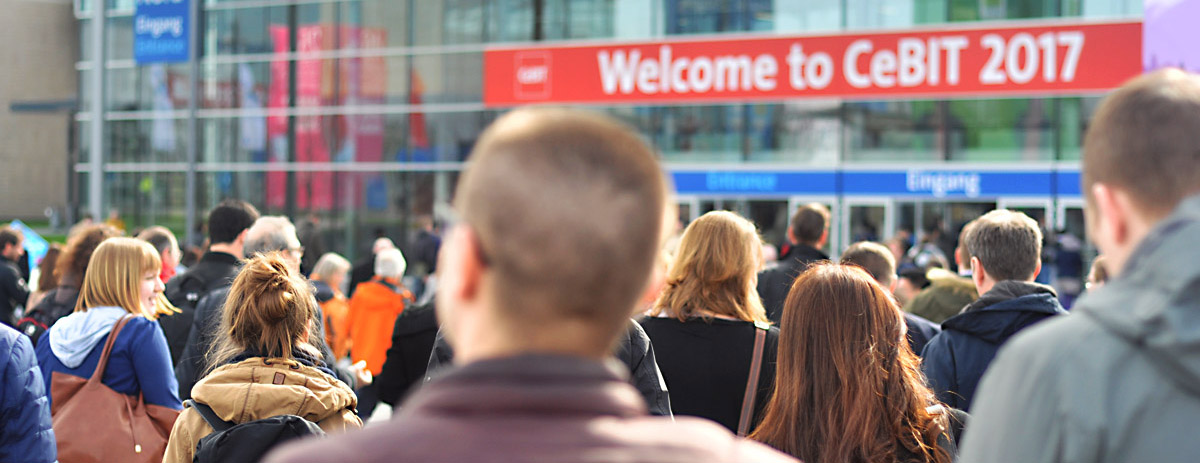
One of the World’s greatest technology fairs ended last week, leaving a deep impact in the minds of the participants. It became obvious that we are heading towards some major milestones in IC&T. So the message was about the current trends that are beginning to take shape, redefining the close future. A few of these directions that are getting closer to a mature phase are presented here.

Drones
The drones presented at CeBIT 2017 where nothing less than impressive. Certainly it is not the first time this technology is being showcased, but now we begin to see some of the first mature applications. There were drone swarms (formations of drones), devices that are interconnected to perform team jobs. This builds upon the limitations of a single unit while adding news attributes such as swarm reaction, strategic intervention and increased team dynamics.
Some were intervention drones equipped with robotic arms, to performs various tasks in remote locations. These are also useful to save costs and preserve the lives of human workers previously doing the dangerous jobs (electric cables, defusing, hazardous environments, etc):

The surveillance drones are not new, but seeing the long range variants was certainly impressive.


While some of the designs go up in scale, covering longer ranges with autonomous drone control and bigger batteries, the opposite was also presented at CeBIT as tiny flying devices, remotely controllable.

And finally, there were also drone racing contests, where the pilots were humans (remember Ender’s Game?), but the very same can be done with silicon, improving the reaction times a few thousand times. Imagine that, as it was scary already.

Robots
While the true AI still has a long way to go, starting something is the first step to a result. A team of robots where happily demoing their soccer skills, a game that involves team synchronisation, environmental awareness, strategy and many sensors to achieve “the simple” task of scoring a goal:
Nothing of the above complexity, some robots where there only for the show, dancing. Kids are not to be neglected so there are plenty of applications for the little white guy too:
Back to more serious stuff, a research team founded by the German government (why don’t we have this in Romania?!) came up with multiple autonomous rovers designed to walk the surface of alien worlds. How exciting is that!

These were a combination of sensors and automation routines to allow them to perform complicated tasks in hazardous environments.

Resembling the Tin Man, the operator robot was quietly completing his task for the day, or for the night, as it is obvious one of these could go on continuously, while his power cord is connected. Surely a great way of boosting the production capabilities.
A bit on a different direction, the exo skeletons are a robotic technology that can augment the human capabilities to a new level. This was just for the show, but where this goes is obvious:
And yes, it doesn’t have to be a full suit to help, like for example, replacing a missing arm:

Internet of Things
IOT became part of our homes, the industrial production processes, we even wear them in watches or glasses. We took small steps to get here, but it is clear the world was changed. Technology is now part of our lives, in the very same way the electric bulb is a must have today. The uRADMonitor network has seen the beginning of this direction, and evolved ever since. The first uRADMonitor hardware design used Ethernet connectivity to measure background radioactivity automatically, saving considerable electric power and resources in the process. The uRADMonitor project was showcased at CeBIT 2017:

As the IOT is shaping to better fit our needs, we already see various ready-for-market applications:


Even the parking lots can be monitored, saving time and managing the City resources better with this sensor from ZTE:

Surely, many things will change, and one of major importance in IOT is security. IOT spawned from the enthusiasm of automating our lives, and in the speedy development security was sometimes neglected. A small reminder on that came live from Edward Snowden, former CIA employee, showing how technology that invades our personal space can do us harm:
Computers evolved, opening the path to all these exciting applications. Processing power costs less , both in terms of money and operating power, and it will not stop here. The robots, the drones, our phones, our smart TVs are all examples of how miniaturisation of the digital technology transformed regular products into tiny computational units, ready to serve our needs. This is the world of today, and CeBIT made it clear. Technology it is here to stay, and our world is transformed in a new, digital direction.

A word of ending
Machines are faster, smarter and this is only the beginning. One day they’ll break the barrier that keeps them dependant to human instructions. That is where evolution will mark a new milestone in, hopefully, the continuation of mankind.
To cut the apocalyptic scenario, this event was also about people and about strengthening our relations beyond the geopolitical barriers, about trade and competitiveness, natural processes that ultimately serve our progress:

And to be honest, as the fair was in Hannover I should add that the human element is probably unique in recognising the excellent taste of a good German beer:

These are the premises. Are you ready for the future?
codemore code
~~~~